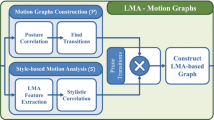Abstract
Charisma Cam is a software for real-time behavioral analysis, based on Automatic Movie Analysis (AMA). It extracts information from human body language, using the Motion Energy Detection (MED) approach. It detects changes in shapes, rather than trying to build complex mathematical models of individual body movements. This allows for quantitative assessment of movement qualities independently of their Gestalt. The demo shows a system that generates a personality profile for the ”Big 5” by analyzing human body movements (dancing) in real time. In a way Charisma Cam simulates low-level vision-processing algorithms of the human brain. Thus it can be seen as a prototype of an intelligent Digital Sensory Organ that could augment simulation engines for virtual humans in future.
Preview
Unable to display preview. Download preview PDF.
Similar content being viewed by others
References
Cutting, J.E., Proffitt, D.R., Kozlowski, L.T.: A biomechanical invariant for gait perception. J. Exp. Psychol. Human Perception Performance 4, 357–372 (1978)
Dittrich, W.H., Troscianko, T., Lea, S.E., Morgan, D.: Perception of emotion from dynamic point-light displays represented in dance. Perception 25, 727–738 (1996)
Grammer, K., Honda, R., Juette, A., Schmitt, A.: Fuzziness of Non-verbal Courtship Communication: Unblurred by Automatic Movie Analysis. J. Pers. Soc. Psychol. 77(3), 487–508 (1999)
Grammer, K., Keki, V., Stribel, B., Atzmüller, M., Fink, B.: Bodies in Motion: A Window to the Soul. In: Voland, E., Grammer, K. (eds.) Evolutionary Aesthetics, pp. 295–323. Springer, Heidelberg (2003)
Grammer, K., Filova, V., Fieder, M.: The Communication Paradox and Possible Solutions. In: Schmitt, A., Atzwanger, K., Grammer, K., Schäfer, K. (eds.) New Aspects of Human Ethology, pp. 91–120. Plenum Press, New York (1997)
Gray, J.A.: Framework for a taxonomy of psychiatric disorders. In: van Goozen, S.H.M., van de Poll, N.E., Sergeant, J. (eds.) Emotions: Essays on Emotion Theory, pp. 29–59. Erlbaum, Hillsdale (1994)
Gray, J.A.: Neuropsychological Theory of Anxiety: An Investigation of the Septal-Hippocampal System. Cambridge University Press, Cambridge (1982)
Lippa, R.A., Dietz, J.K.: The Relation of Gender, Personality, and Intelligence to Judges’ Accuracy in Judging Strangers. Personality from Brief Video Segments’. Journal of Nonverbal Behavior 24(1), 25–43 (2000)
Kenny, D.A., Horner, C., Kashy, D.A., Chu, L.: Consensus at Zero Acquaintance: Replication, Behavioral Cues, and Stability. Journal of Personality and Social Psychology 62(1), 88–97 (1992)
Grammer, K., Atzmüller, M., Costa, M., Fink, B., Oberzaucher, E.: Testosterone, Motor Behavior, and Sensation Seeking in Young Males. Neuroendocrinological Letters (in press)
Grammer, K., Fink, B., Renninger, L.: Dynamic Systems and Inferential Information Processing in Human Communication. Special Issue Neuro Endocrinological Letters 23(4), 15–22 (2002)
Ostendorf, F.: Sprache und Persönlichkeitsstruktur: Zur Validität des fünf Faktoren Modells der Persönlichkeit Regensburg: Roderer (1990)
Waibel, A., Hanazawa, T., Hinton, G., Shikano, K., Lang, K.: Phoneme recognition using time-delay neural networks. IEEE Trans Acoustics Speech and Signal Processing 37(3), 328–339 (1989)
Costa, P.T.J., McCrae, R.R.: Revised NEO Personality Inventory and NEO Five-Factor Inventory Professional Manual. Odessa, FL: Psychological Assessment Resources
Author information
Authors and Affiliations
Editor information
Editors and Affiliations
Rights and permissions
Copyright information
© 2003 Springer-Verlag Berlin Heidelberg
About this paper
Cite this paper
Bechinie, M., Grammer, K. (2003). Charisma Cam: A Prototype of an Intelligent Digital Sensory Organ for Virtual Humans. In: Rist, T., Aylett, R.S., Ballin, D., Rickel, J. (eds) Intelligent Virtual Agents. IVA 2003. Lecture Notes in Computer Science(), vol 2792. Springer, Berlin, Heidelberg. https://doi.org/10.1007/978-3-540-39396-2_35
Download citation
DOI: https://doi.org/10.1007/978-3-540-39396-2_35
Publisher Name: Springer, Berlin, Heidelberg
Print ISBN: 978-3-540-20003-1
Online ISBN: 978-3-540-39396-2
eBook Packages: Springer Book Archive




